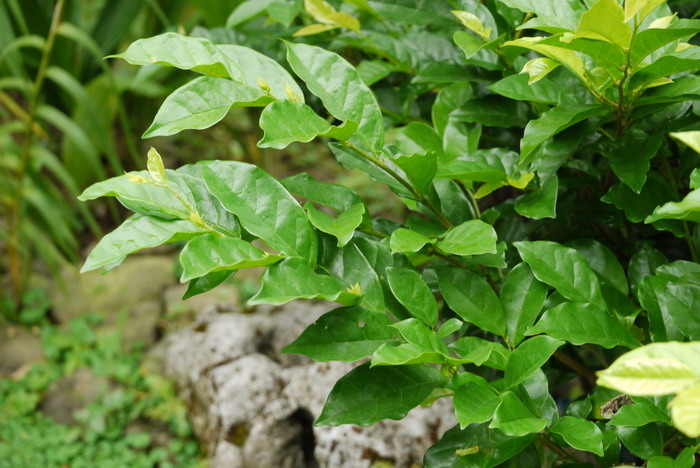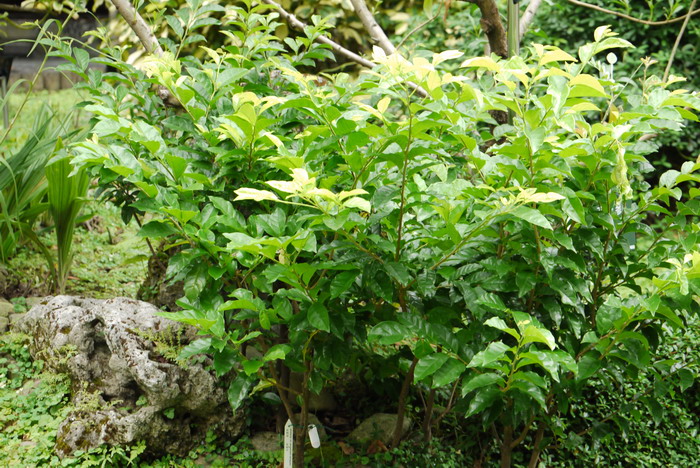日本五月茶Antidesma japonicum
中文名(Chinese Name):日本五月茶
学名(Scientific Name):Antidesma japonicum Sieb. et Zucc.
英文名(English Common Name):
别名(Chinese Common Name):枯里珍、酸味子
异名(Synonym):Antidesma ambiguum Pax et Hoffm. Antidesma pentandrum (Blanco) Merr. Antidesma pentandrum var. barbatum (Presl) Merr. Antidesma pentandrum var. rotundisepalum (Hayata) Hurus. Antidesma rostratum var. barbatum (C. Presl) Müll. Arg. Antidesma rotundisepalum Hayata Antidesma delicatulum Hutch. Antidesma barbatum C. Presl Antidesma kotoense Kaneh. Antidesma japonicum var. densiflorum Hurus. Antidesma pentandrum var. hiiranense (Hayata) Hurus. Antidesma filipes Hand.-Mazz. Antidesma acutisepalum Hayata Antidesma gracile Hemsl. Antidesma gracillimum Gage Antidesma hiiranense Hayata Antidesma japonicum var. acutisepalum (Hayata) Hurus.
科属(Family & Genus):戟科(Euphorbiaceae)五月茶属
形态特征(Description):乔木或灌木,高2-8米;小枝初时被短柔毛,后变无毛。叶片纸质至近革质,椭圆形、 长椭圆形至长圆状披针形,稀倒卵形,长3.5-13厘米,宽1.5-4厘米,顶端通常尾状渐尖,有小尖头,基部楔形、钝或圆,除叶脉上被短柔毛外,其余均无毛;侧脉每边5-10条,在叶面扁平,在叶背略凸起;叶柄长5-10毫米,被短柔毛至无毛;托叶线形,早落。总状花序顶生,长达10厘米,不分枝或有少数分枝;雄花:花梗长约0.5毫米,被疏微毛至无毛,基部具有披针形的小苞片;花萼钟状,长约0.7毫米,3-5裂,裂片卵状三角形,外面被疏短柔毛,后变无毛;雄蕊2-5,伸出花萼之外,花丝较长,着生于花盘之内;花盘垫状;雌花:花梗极短;花萼与雄花的相似,但较小;花盘垫状,内面有时有1-2枚退化雄蕊;子房卵圆形,长1-1.5毫米,无毛,花柱顶生,柱头2-3裂。核果椭圆形,长约5-6毫米。花期4-6月,果期7-9月。
分布(Distribution):产我国长江以南各省区,生于海拔300-1700米山地疏林中或山谷湿润地方。日本、越南、泰国及马来西亚也有。
用途(Use):为热带及亚热带森林中常见树种。种子含油量48% ,为以亚麻酸为主的油脂。
引自中国植物志英文版FOC Vol. 11 Page 210, 213
Antidesma japonicum Siebold & Zuccarini, Abh. Math.-Phys. Cl. Königl. Bayer. Akad. Wiss. 4(3): 212. 1846.
酸味子 suan wei zi | Euphorbiaceae | Antidesma
Antidesma acutisepalum Hayata; A. ambiguum Pax & K. Hoffmann; A. delicatulum Hutchinson; A. filipes Handel-Mazzetti; ?A. gracillimum Gage; A. hiiranense Hayata; A. japonicum var. acutisepalum (Hayata) Hurusawa; A. japonicum var. densiflorum Hurusawa; A. neriifolium Pax & K. Hoffmann; A. pentandrum Merrill var. hiiranense (Hayata) Hurusawa.
Shrubs or small trees 2-8 m tall; young twigs delicate, pubescent when young, glabrescent. Stipules linear, 2-5 × 0.7-1 mm, caducous; petiole 2-10 mm, pubescent to glabrous; leaf blade elliptic or oblong-elliptic to oblong-lanceolate, rarely obovate, 3.5-13 × (1-)1.5-4.5 cm, papery to subleathery, glabrous except for midvein sometimes pubescent, shiny and drying light olive to grayish green on both sides, base acute, obtuse, or rounded, apex acuminate or acute, sometimes caudate, mucronulate; midvein impressed or flat adaxially, lateral veins 5-12 pairs, tertiary veins weakly percurrent to reticulate. Inflorescences terminal or axillary, slender, lax-flowered, 2-6 cm, fruiting 4-10 cm, males unbranched to 6-branched, females unbranched or 2-branched at most, axes glabrous to puberulent. Male flowers: pedicels (0.5-)1-1.5 mm, fruiting (2-)3-6 mm, puberulent to glabrous; sepals 3-5, free or nearly so, 0.4-0.7 mm, ovate to triangular, glabrous; disk cushion-shaped, fully or partially enclosing bases of filaments and pistillode, glabrous; stamens 3-5, 1-2 mm; rudimentary ovary absent, flat, clavate, cylindric, or 3-fid. Female flowers: calyx as in male; disk glabrous; ovary glabrous; stigmas 2-5. Drupes ellipsoid, laterally compressed, 5-6(-8) × 4-6(-8) mm; style (sub)terminal. Fl. Apr-Aug, fr. Jun-Sep.
Open forests in humid valleys, rarely in scrub on limestone; 300-1700 m. Anhui, Fujian, Guangdong, Guangxi, Guizhou, Hainan, Hubei, Hunan, Jiangsu, Jiangxi, Qinghai, Sichuan, Taiwan, Xizang, Yunnan, Zhejiang [Japan, Malaysia, Thailand, Vietnam].
The seeds yield up to 48% oil.
Antidesma ambiguum is a new synonym here. In the key accompanying the protologue, the two species are solely distinguished by pubescent vs. glabrescent young twigs; both of these occur in A. japonicum.
The concept of Antidesma pentandrum (here treated as a synonym of A. montanum ) in some respects bridges the gap between A. japonicum and A. montanum. Further studies in the northern geographic range of the genus might show the need to subsume A. japonicum under A. montanum.
Sometimes 1 or 2 staminodes may be found in female flowers. This occurs in some other species of Antidesma but is very rare.
The Chinese material all belongs to Antidesma japonicum var. japonicum ; A. japonicum var. robustius Airy Shaw differs most obviously by the midrib which is distinctly raised adaxially; it is endemic to Thailand.


(责任编辑:徐晔春)
学名(Scientific Name):Antidesma japonicum Sieb. et Zucc.
英文名(English Common Name):
别名(Chinese Common Name):枯里珍、酸味子
异名(Synonym):Antidesma ambiguum Pax et Hoffm. Antidesma pentandrum (Blanco) Merr. Antidesma pentandrum var. barbatum (Presl) Merr. Antidesma pentandrum var. rotundisepalum (Hayata) Hurus. Antidesma rostratum var. barbatum (C. Presl) Müll. Arg. Antidesma rotundisepalum Hayata Antidesma delicatulum Hutch. Antidesma barbatum C. Presl Antidesma kotoense Kaneh. Antidesma japonicum var. densiflorum Hurus. Antidesma pentandrum var. hiiranense (Hayata) Hurus. Antidesma filipes Hand.-Mazz. Antidesma acutisepalum Hayata Antidesma gracile Hemsl. Antidesma gracillimum Gage Antidesma hiiranense Hayata Antidesma japonicum var. acutisepalum (Hayata) Hurus.
科属(Family & Genus):戟科(Euphorbiaceae)五月茶属
形态特征(Description):乔木或灌木,高2-8米;小枝初时被短柔毛,后变无毛。叶片纸质至近革质,椭圆形、 长椭圆形至长圆状披针形,稀倒卵形,长3.5-13厘米,宽1.5-4厘米,顶端通常尾状渐尖,有小尖头,基部楔形、钝或圆,除叶脉上被短柔毛外,其余均无毛;侧脉每边5-10条,在叶面扁平,在叶背略凸起;叶柄长5-10毫米,被短柔毛至无毛;托叶线形,早落。总状花序顶生,长达10厘米,不分枝或有少数分枝;雄花:花梗长约0.5毫米,被疏微毛至无毛,基部具有披针形的小苞片;花萼钟状,长约0.7毫米,3-5裂,裂片卵状三角形,外面被疏短柔毛,后变无毛;雄蕊2-5,伸出花萼之外,花丝较长,着生于花盘之内;花盘垫状;雌花:花梗极短;花萼与雄花的相似,但较小;花盘垫状,内面有时有1-2枚退化雄蕊;子房卵圆形,长1-1.5毫米,无毛,花柱顶生,柱头2-3裂。核果椭圆形,长约5-6毫米。花期4-6月,果期7-9月。
分布(Distribution):产我国长江以南各省区,生于海拔300-1700米山地疏林中或山谷湿润地方。日本、越南、泰国及马来西亚也有。
用途(Use):为热带及亚热带森林中常见树种。种子含油量48% ,为以亚麻酸为主的油脂。
引自中国植物志英文版FOC Vol. 11 Page 210, 213
Antidesma japonicum Siebold & Zuccarini, Abh. Math.-Phys. Cl. Königl. Bayer. Akad. Wiss. 4(3): 212. 1846.
酸味子 suan wei zi | Euphorbiaceae | Antidesma
Antidesma acutisepalum Hayata; A. ambiguum Pax & K. Hoffmann; A. delicatulum Hutchinson; A. filipes Handel-Mazzetti; ?A. gracillimum Gage; A. hiiranense Hayata; A. japonicum var. acutisepalum (Hayata) Hurusawa; A. japonicum var. densiflorum Hurusawa; A. neriifolium Pax & K. Hoffmann; A. pentandrum Merrill var. hiiranense (Hayata) Hurusawa.
Shrubs or small trees 2-8 m tall; young twigs delicate, pubescent when young, glabrescent. Stipules linear, 2-5 × 0.7-1 mm, caducous; petiole 2-10 mm, pubescent to glabrous; leaf blade elliptic or oblong-elliptic to oblong-lanceolate, rarely obovate, 3.5-13 × (1-)1.5-4.5 cm, papery to subleathery, glabrous except for midvein sometimes pubescent, shiny and drying light olive to grayish green on both sides, base acute, obtuse, or rounded, apex acuminate or acute, sometimes caudate, mucronulate; midvein impressed or flat adaxially, lateral veins 5-12 pairs, tertiary veins weakly percurrent to reticulate. Inflorescences terminal or axillary, slender, lax-flowered, 2-6 cm, fruiting 4-10 cm, males unbranched to 6-branched, females unbranched or 2-branched at most, axes glabrous to puberulent. Male flowers: pedicels (0.5-)1-1.5 mm, fruiting (2-)3-6 mm, puberulent to glabrous; sepals 3-5, free or nearly so, 0.4-0.7 mm, ovate to triangular, glabrous; disk cushion-shaped, fully or partially enclosing bases of filaments and pistillode, glabrous; stamens 3-5, 1-2 mm; rudimentary ovary absent, flat, clavate, cylindric, or 3-fid. Female flowers: calyx as in male; disk glabrous; ovary glabrous; stigmas 2-5. Drupes ellipsoid, laterally compressed, 5-6(-8) × 4-6(-8) mm; style (sub)terminal. Fl. Apr-Aug, fr. Jun-Sep.
Open forests in humid valleys, rarely in scrub on limestone; 300-1700 m. Anhui, Fujian, Guangdong, Guangxi, Guizhou, Hainan, Hubei, Hunan, Jiangsu, Jiangxi, Qinghai, Sichuan, Taiwan, Xizang, Yunnan, Zhejiang [Japan, Malaysia, Thailand, Vietnam].
The seeds yield up to 48% oil.
Antidesma ambiguum is a new synonym here. In the key accompanying the protologue, the two species are solely distinguished by pubescent vs. glabrescent young twigs; both of these occur in A. japonicum.
The concept of Antidesma pentandrum (here treated as a synonym of A. montanum ) in some respects bridges the gap between A. japonicum and A. montanum. Further studies in the northern geographic range of the genus might show the need to subsume A. japonicum under A. montanum.
Sometimes 1 or 2 staminodes may be found in female flowers. This occurs in some other species of Antidesma but is very rare.
The Chinese material all belongs to Antidesma japonicum var. japonicum ; A. japonicum var. robustius Airy Shaw differs most obviously by the midrib which is distinctly raised adaxially; it is endemic to Thailand.
(责任编辑:徐晔春)
踩一下[0]

顶一下[0]